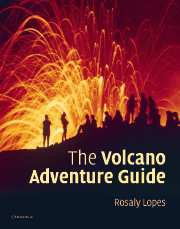Book contents
- Frontmatter
- Contents
- Preface
- Acknowledgments
- PART I Choosing a volcano to visit
- PART II Guides to volcanoes
- 6 Introduction to the field guides
- 7 Volcanoes in Hawaii
- 8 Volcanoes in the continental USA
- 9 Volcanoes in Italy
- 10 Volcanoes in Greece
- 11 Volcanoes in Iceland
- 12 Volcanoes in Costa Rica
- 13 Volcanoes in the West Indies
- Appendix I Useful information for preparing a volcano trip
- Appendix II Tours to volcanoes
- Bibliography
- Glossary
- Index
11 - Volcanoes in Iceland
from PART II - Guides to volcanoes
Published online by Cambridge University Press: 01 September 2010
- Frontmatter
- Contents
- Preface
- Acknowledgments
- PART I Choosing a volcano to visit
- PART II Guides to volcanoes
- 6 Introduction to the field guides
- 7 Volcanoes in Hawaii
- 8 Volcanoes in the continental USA
- 9 Volcanoes in Italy
- 10 Volcanoes in Greece
- 11 Volcanoes in Iceland
- 12 Volcanoes in Costa Rica
- 13 Volcanoes in the West Indies
- Appendix I Useful information for preparing a volcano trip
- Appendix II Tours to volcanoes
- Bibliography
- Glossary
- Index
Summary
Iceland
God may have been thinking of geologists when He created Iceland. Here the outcrops are unrivaled, unobscured by trees, and set amongst unspoiled, uncrowded, and breathtakingly beautiful wilderness. Anyone seriously interested in volcanoes should have Iceland in their must–see list. Located atop the mid–Atlantic ridge, which cuts across the island from the southwest to the north, Iceland has all of the tectonic and volcanic ingredients of a typical mid–oceanic ridge, including spectacular gaping fissures that result from the spreading of the Earth's crust. The ridge, however, is only part of the story: Iceland is also placed above an oceanic hot spot, which results in a much greater yield of molten magma than is typical for mid–oceanic ridges. In fact, Iceland has produced one–third of all the lava erupted on Earth during the last 1,000 years. The interplay between hot spot and mid–oceanic ridge volcanism is responsible for Iceland's very high rate of magma production, which over millions of years has constructed a richly varied landscape. Here one finds not only basaltic shield volcanoes, typical of mid–oceanic ridges, but also features formed by silicic magmas (mainly rhyolites and andesites), which are usually associated with subduction zones. These include pyroclastic flows and widespread ash deposition from Plinian eruptions. The silicic magma beneath Iceland is produced by partial melting of the lower basaltic crust, caused by the high temperatures above Iceland's hot spot.
- Type
- Chapter
- Information
- The Volcano Adventure Guide , pp. 239 - 271Publisher: Cambridge University PressPrint publication year: 2005

